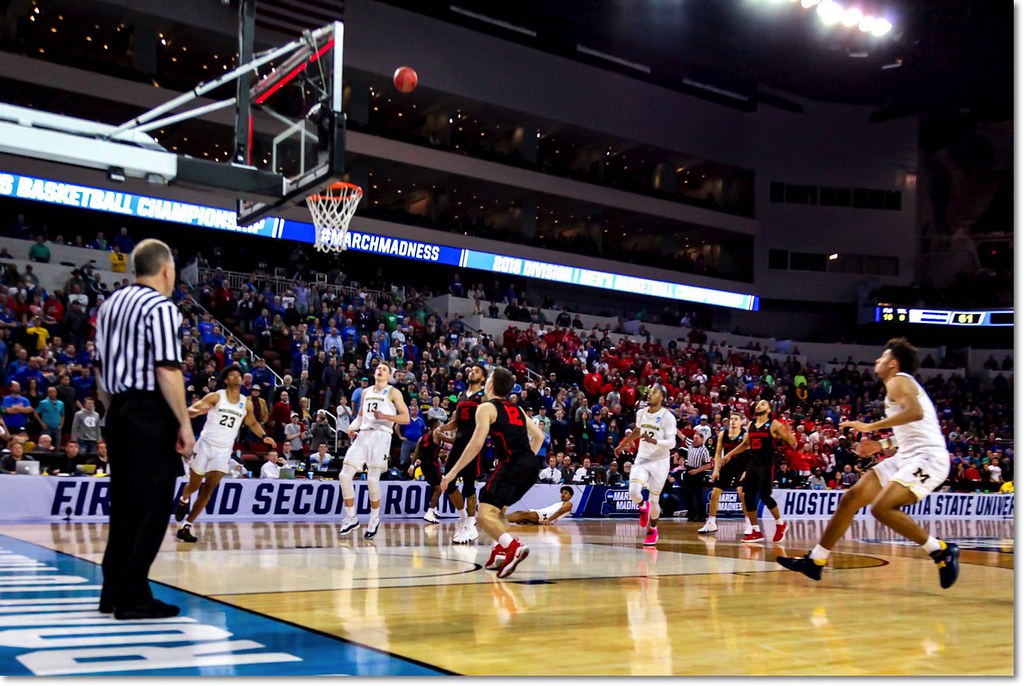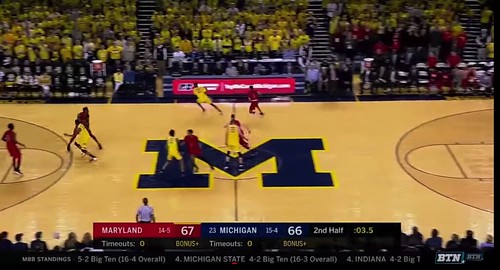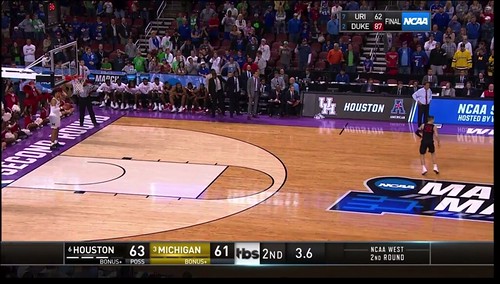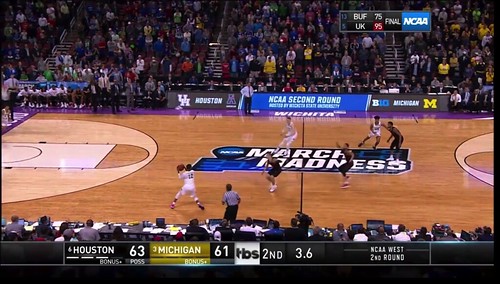trey burke is definitely not human

You know what it is. Stream starts at 8 pm ET. You can watch the embed below or head over to twitch.tv/mgoace to participate in the live chat. We're going to attempt to have Brian join me on the commentary again tonight. If we run into technical issues, I'll go solo for the duration.
I still have no idea how this worked out.

Previously: Part One
After looking at Michigan's stellar pick-and-roll production and how they do it last week, I dove deeper into Synergy's database to try to put this year's team in a historical context. At first I was just looking at other lead ballhandlers, then I was putting tables for every season together, then I realized I needed to add the screeners to the equation and look at how each team varied their P&R attack to do this right.
So what was going to be the second half of this series is now the second of either three or four parts. I'm trying not to make these too long to digest. These posts are going to be heavy on Synergy's stats, so I want to make a few notes before going any further.
While Synergy uses the terminology "points per possession" to describe how they measure production, that's very misleading when you're used to looking at KenPom. I'm switching over to describing Synergy stats as "points per play." The distinction is described in this useful Cleaning The Glass post:
CTG distinguishes between possessions and plays, and this distinction is important when diving into context information. A possession starts when a team gets the ball and ends when they lose it. A play ends when the team attempts a shot, goes to the foul line, or turns the ball over. If a team gets an offensive rebound, that results in a continuation of a possession but a new play. So a possession can have multiple plays.
Play contexts are per-play, not per-possession. For example, a team might come down in transition and miss a shot, get the offensive rebound, kick it out, and run a halfcourt set. Then might miss that shot but get a tip in to score and end the possession. That was all one possession, but three different plays and three different contexts: the first shot was in transition, the second in the halfcourt, and the third was a putback.
Because offensive rebounds start a new "play" within a possession, points per play are inherently going to be lower than points per possession. To help contextualize, I've included each player's national percentile rank for that season along with their stats.
For ballhandlers, "own offense" includes plays that finish with a field goal attempt, shooting foul, or turnover. "Passes" measure the result of shots that come as a direct result of the ballhandler's pass out of the pick-and-roll. "Keep percentage" is a stat I added myself that simply measures the percentage of a time the ballhandler uses his own offense instead of recording a passing play—Michigan has had players arrive at similar efficiency despite sporting very different styles.
an enjoyable pick-and-pop example
For screeners, you mostly just need to know the difference between popping, rolling, and slipping a screen:
- Popping: setting the screen and then stepping out (usually to the three-point line) for what's almost always a spot-up shot. Occasionally a more versatile big man will drive off a pop. Think Moe Wagner.
- Rolling: setting the screen and then going to the basket in the hopes of getting a layup/dunk. Think Jordan Morgan.
- Slipping: faking the screen before running to a predesignated spot—usually the rim, sometimes spotting up if it's a Wagner-type or perimeter player—as a changeup to keep defenses from overplaying the ballhandler.
As a general rule, points per play are going to higher when the screener finishes the play than the ballhander because of the nature of the pick-and-roll. A pass is usually going to be thrown to an open man when the play works; while the ballhandler could take a shot because he got open himself, he also usually has to finish the play if it's well defended.
Consider the degree of difficulty of Zavier Simpson's or Cassius Winston's shots; it's hard to be a really efficient scorer off the pick-and-roll. Morgan, while a great roll man, often just had to catch the ball and finish an uncontested shot at the rim. Most of Wagner's pick-and-pop threes went up without a real shot contest. This makes sense: there's little reason to pass the ball to your big man if he isn't open. Teams also often default to a quick screen in late clock situations, which tends to create more difficult shots the ballhandler has little choice but to take.
The other thing to note in the screener stats: under number of plays in each category, "%" shows the percentage of the time each player popped, rolled, or slipped out of their overall screener plays used. The "%ile" under points points play in each category, however, measures percentile national rank. I realize this is a little confusing but I couldn't come up with a better way than Synergy in this case.
With that out of the way, let's dive in.
[Hit THE JUMP for a year-by-year history of Michigan's pick-and-roll offense and what we can learn from it.]

Yes, this still somehow went in. [JD Scott]
Another tournament week, another multi-part mailbag. This one contains the questions about/inspired by Jordan Poole's buzzer-beater. Yes, I'm as shocked as you are that I sorted them this way. Jump in!
A Free Pass
Hey Ace - Are there any statistics showing whether teams should guard the inbounder in late game situations like against Houston? On the surface, it seems like a huge mistake to let Livers inbound the ball to halfcourt so easily.
-Pat
While I don't remember seeing such a study and can't find stats on it, I agree that Kelvin Sampson erred in allowing Isaiah Livers to get a clean look on the final play. An opposing staff can only scout so many games, but I'm guessing Houston's coaches didn't get to the Maryland tape.
Even though the outcome of the plays were wildly different, Michigan's game-winners against the Terps and Cougars came on nearly identical setups: Livers hitting Muhammad-Ali Abdur-Rahkman with a baseball pass from his own baseline out of a timeout. Neither opponent elected to guard the inbounder even though Livers wasn't allowed to run the baseline.
Maryland's Mark Turgeon explicitly tried to set up his defense to prevent anyone from catching a pass while running towards the Terps basket. Here's how that went:


If you forgot, MAAR nearly got all the way to the hoop, drew a foul, and drained both free throws with the ruthless calm of a serial killer.
Here was Houston's setup:

While the Cougars were more successful in preventing a long pass to a guy on a dead run, they still allowed MAAR to catch the ball a fair distance up the court without any immediate pressure, which let him get upcourt in a hurry even though they had two defenders waiting.

Houston forced a tough shot, but it was still a catch-and-shoot look from a not-entirely-unreasonable distance by a shooter who had the time and space to square up to the basket. That's not a prayer, at least if you're Jordan Poole; ideally, the defense is forcing teams into prayers in that situation.
I don't think having the extra defender back is worth whatever added coverage it provides. Again, Livers can't run the baseline in either of these cases, and he's being asked to throw accurate passes far downcourt. Stick a big man on him and that becomes a great deal more difficult to execute. A tougher pass for Livers means either MAAR has to run farther back to the ball—losing precious time and momentum—or risk never completing the pass at all on a deeper attempt. Beilein's now gushed twice this season about Livers being able to throw pinpoint baseball passes; that's a lot harder to do with a basketball when you're not getting the same amount of space as an actual baseball pitcher.
Recency and confirmation biases may be playing a factor, but I rarely find the fifth defender that stays back even comes into play that often. For the offense, the downside of having the entire court to cover can also be an upside—your players can sprint full-out, which never happens for more than a couple steps in a halfcourt situation. Even with the extra man back, it's hard to keep a team from hitting the player they want—usually after running him through a couple screens—and that can lead, as in Maryland's case, to getting a bunch of players uselessly stuck behind the play while a fast man runs past them.
Houston more productively spent their extra player on MAAR and he still had an easy pass to make because of the amount of space he had on the catch. They did a much better job on the back end than Maryland by preventing MAAR from either driving or pulling up. They still got burned. I thought everyone learned this lesson in 1992: guard the dang inbounder.
Or don't, actually. Coaches not doing that is working out pretty nicely for my life.
[Hit THE JUMP for my top-five last-shot-makers of the Beilein era, an evil question that was also the most popular, and MAAR's overlooked move.]
6